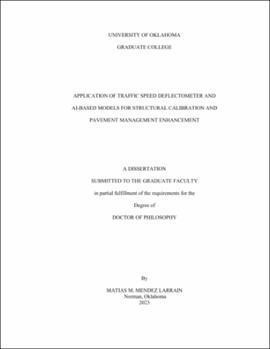| dc.description.abstract | Currently, different methods are used for the evaluation of pavement conditions including the surface, base, subbase, and subgrade. Among these, Falling Weight Deflectometer (FWD) and/or Fast Falling Weight Deflectometer (FFWD), a non-destructive method, is widely used for pavement condition monitoring and forensic studies. Its ability to back-calculate the elastic moduli or stiffness of different layers can be a useful tool for estimating the remaining life of the pavement based on the rutting and cracking criteria. Currently, several state Departments of Transportation (DOTs) use FWD in their preventive maintenance program at both project level and network level. Collection of FWD and FFWD data requires traffic control and disruptions to traffic flow. The Traffic Speed Deflectometer (TSD) is an instrumented vehicle that is capable of measuring deflection, International Roughness Index (IRI), rut depths and other distresses at traffic speed without requiring any traffic control.
Reflection cracking, edge cracking, rut and longitudinal edge depressions are some of the major problems in asphalt pavements near the intersection of Interstate 35 (I-35) and State Highway 7 (SH-7) in Oklahoma. In this study, over forty (40) miles of FFWD and TSD test data were collected from SH-7 and I-35. More than 380 FFWD tests were conducted at different locations throughout the studied sections. Deflections at different sensors and temperatures during testing were recorded. Also, TSD data were collected from the same pavement sections, as part of a nationwide pool fund study involving the Oklahoma Department of Transportation (ODOT). Specifically, deflections, rut depths, roughness, temperatures, loading and distress data were collected. Thicknesses of different layers were determined from the Ground Penetration Radar (GPR) and from coring. From these data, two different types of pavements were identified under the Asphalt Concrete (AC) layer in the studied section of I-35, namely Jointed Concrete Pavement (JCP) and Continuously Reinforced Concrete Pavement (CRCP). The pavement structure in SH-7, on the other hand, consisted of only AC layers over native subgrade soil. The following laboratory performance tests were conducted on the extracted asphalt cores: Semi-Circular Bend (SCB), Texas Overlay (TO), Tensile Strength Ratio (TSR), Indirect Tensile Asphalt Cracking (IDEAL-CT), and Hamburg Wheel Tracking (HWT). Also, roughness and rut data were collected by Pave3D 8k, in collaboration with the Oklahoma State University team, and compared with the corresponding TSD data. In addition, elastic moduli obtained from the FWD and TSD data were compared in this study. For this purpose, FWD data were used in Modulus 7.0 Software to back-calculate elastic modulus. The deflection values from the TSD data were reformatted and used in Modulus 7.0 to determine the corresponding elastic moduli. A linear elastic model option in KENLAYER was used to determine strains at the bottom of the AC layer. These strains were then used to calibrate the coefficients of the model that are currently used to calculate strains at the bottom of the AC layer from the TSD deflection data. Further, the coefficients used in models by Rhode (1994) and by AASHTO 93 to determine Effective Structural Number (SNeff) were calibrated for both studied sections. Temperature corrections and matching of deflection data obtained from the FWD and TSD testing were needed for these calibrations and their comparison (i.e., FWD vs TSD). Recent developments in Artificial Intelligence (AI)-based models were employed in this study in developing the aforementioned correlations. For comparison purposes, both regression and AI-based models were used to predict the back-calculated elastic moduli values from the TSD data using a Python code. Finally, the predicted elastic moduli (based on the FWD deflections) by linear regressions and Random Forest (RF) models were compared and relative strengths of the AI models discussed. | en_US |
